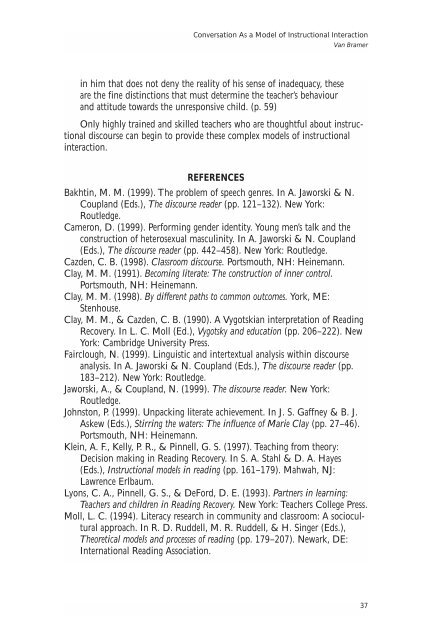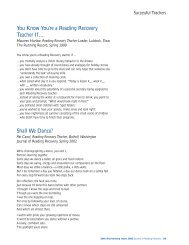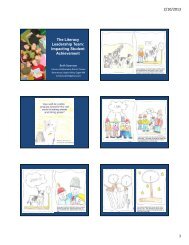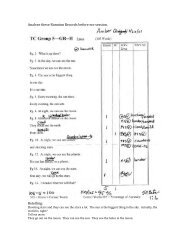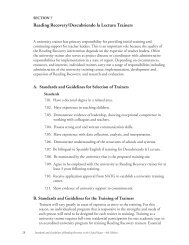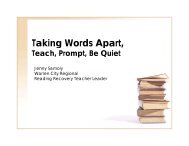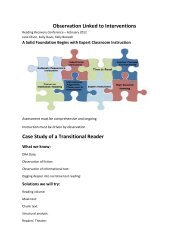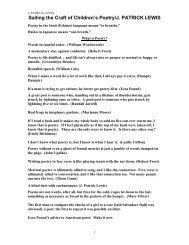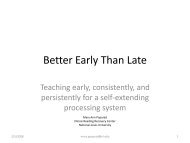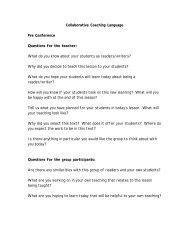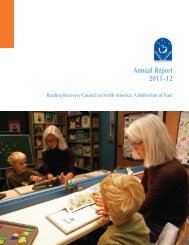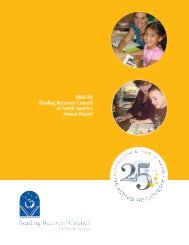Conversation As a Model of Instructional Interaction - Eric
Conversation As a Model of Instructional Interaction - Eric
Conversation As a Model of Instructional Interaction - Eric
You also want an ePaper? Increase the reach of your titles
YUMPU automatically turns print PDFs into web optimized ePapers that Google loves.
layout-8/l-2003 1/7/04 12:29 PM Page 37<strong>Conversation</strong> <strong>As</strong> a <strong>Model</strong> <strong>of</strong> <strong>Instructional</strong> <strong>Interaction</strong>Van Bramerin him that does not deny the reality <strong>of</strong> his sense <strong>of</strong> inadequacy, theseare the fine distinctions that must determine the teacher’s behaviourand attitude towards the unresponsive child. (p. 59)Only highly trained and skilled teachers who are thoughtful about instructionaldiscourse can begin to provide these complex models <strong>of</strong> instructionalinteraction.REFERENCESBakhtin, M. M. (1999). The problem <strong>of</strong> speech genres. In A. Jaworski & N.Coupland (Eds.), The discourse reader (pp. 121–132). New York:Routledge.Cameron, D. (1999). Performing gender identity. Young men’s talk and theconstruction <strong>of</strong> heterosexual masculinity. In A. Jaworski & N. Coupland(Eds.), The discourse reader (pp. 442–458). New York: Routledge.Cazden, C. B. (1998). Classroom discourse. Portsmouth, NH: Heinemann.Clay, M. M. (1991). Becoming literate: The construction <strong>of</strong> inner control.Portsmouth, NH: Heinemann.Clay, M. M. (1998). By different paths to common outcomes. York, ME:Stenhouse.Clay, M. M., & Cazden, C. B. (1990). A Vygotskian interpretation <strong>of</strong> ReadingRecovery. In L. C. Moll (Ed.), Vygotsky and education (pp. 206–222). NewYork: Cambridge University Press.Fairclough, N. (1999). Linguistic and intertextual analysis within discourseanalysis. In A. Jaworski & N. Coupland (Eds.), The discourse reader (pp.183–212). New York: Routledge.Jaworski, A., & Coupland, N. (1999). The discourse reader. New York:Routledge.Johnston, P. (1999). Unpacking literate achievement. In J. S. Gaffney & B. J.<strong>As</strong>kew (Eds.), Stirring the waters: The influence <strong>of</strong> Marie Clay (pp. 27–46).Portsmouth, NH: Heinemann.Klein, A. F., Kelly, P. R., & Pinnell, G. S. (1997). Teaching from theory:Decision making in Reading Recovery. In S. A. Stahl & D. A. Hayes(Eds.), <strong>Instructional</strong> models in reading (pp. 161–179). Mahwah, NJ:Lawrence Erlbaum.Lyons, C. A., Pinnell, G. S., & DeFord, D. E. (1993). Partners in learning:Teachers and children in Reading Recovery. New York: Teachers College Press.Moll, L. C. (1994). Literacy research in community and classroom: A socioculturalapproach. In R. D. Ruddell, M. R. Ruddell, & H. Singer (Eds.),Theoretical models and processes <strong>of</strong> reading (pp. 179–207). Newark, DE:International Reading <strong>As</strong>sociation.37


